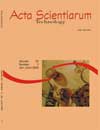<b>Leaching of contaminants in sludge-cement mixture</b> - DOI: 10.4025/actascitechnol.v26i1.1552
DOI:
https://doi.org/10.4025/actascitechnol.v26i1.1552Keywords:
metais pesados, testes de lixiviação, solidificação/estabilização, lodo têxtilAbstract
The laundries sludge has varied chemical composition, and it is considered inadequate for disposing of in sanitary landfill. So, this work presents the physical-chemical characterization of this textile sludge for the study of cement-based solidification /stabilization (S/S) with the addition of Portland cement - CPII F32 or CP II Z. COD total, fixed and volatile solids, density, pH, and the presence of metals were analyzed. Cylindrical samples of paste with 10%, 20% and 30% addition of sludge were submitted to compressive strength tests according to NBR-7215 ABNT norm, and leaching tests according to NBR 10005 ABNT norm. The results demonstrated that in the cement/sludge paste, the values of mechanical resistance of 28 days can be superior to 10 MPa. The beginning of curing period was retarded when the proportion of sludge addition to the cement increases, but maintaining its same order of greatness. Also, the leaching found in the samples of paste without incorporating sludge is about the same order of greatness of that found in samples containing sludge. This allows concluding that the paste permits a safe incorporation of the metals detected in the textile sludge. The presence of metals Fe, Mg, Al, Si, Ca, Cr, Co, Cu, Mn and Zn was detected in the sludgeDownloads
Download data is not yet available.
Downloads
Published
2008-03-31
How to Cite
Pietrobon, C. L. da R., Andrade, C. M. G., Colanzi, J., Barros, I. B. de, Bergamasco, R., & Pietrobon, C. E. (2008). <b>Leaching of contaminants in sludge-cement mixture</b> - DOI: 10.4025/actascitechnol.v26i1.1552. Acta Scientiarum. Technology, 26(1), 45–52. https://doi.org/10.4025/actascitechnol.v26i1.1552
Issue
Section
Chemical Engineering
License
DECLARATION OF ORIGINALITY AND COPYRIGHTS
I Declare that current article is original and has not been submitted for publication, in part or in whole, to any other national or international journal.
The copyrights belong exclusively to the authors. Published content is licensed under Creative Commons Attribution 4.0 (CC BY 4.0) guidelines, which allows sharing (copy and distribution of the material in any medium or format) and adaptation (remix, transform, and build upon the material) for any purpose, even commercially, under the terms of attribution.
Read this link for further information on how to use CC BY 4.0 properly.











8.png)




